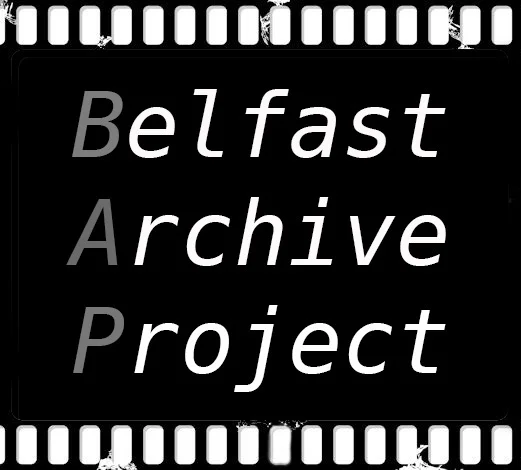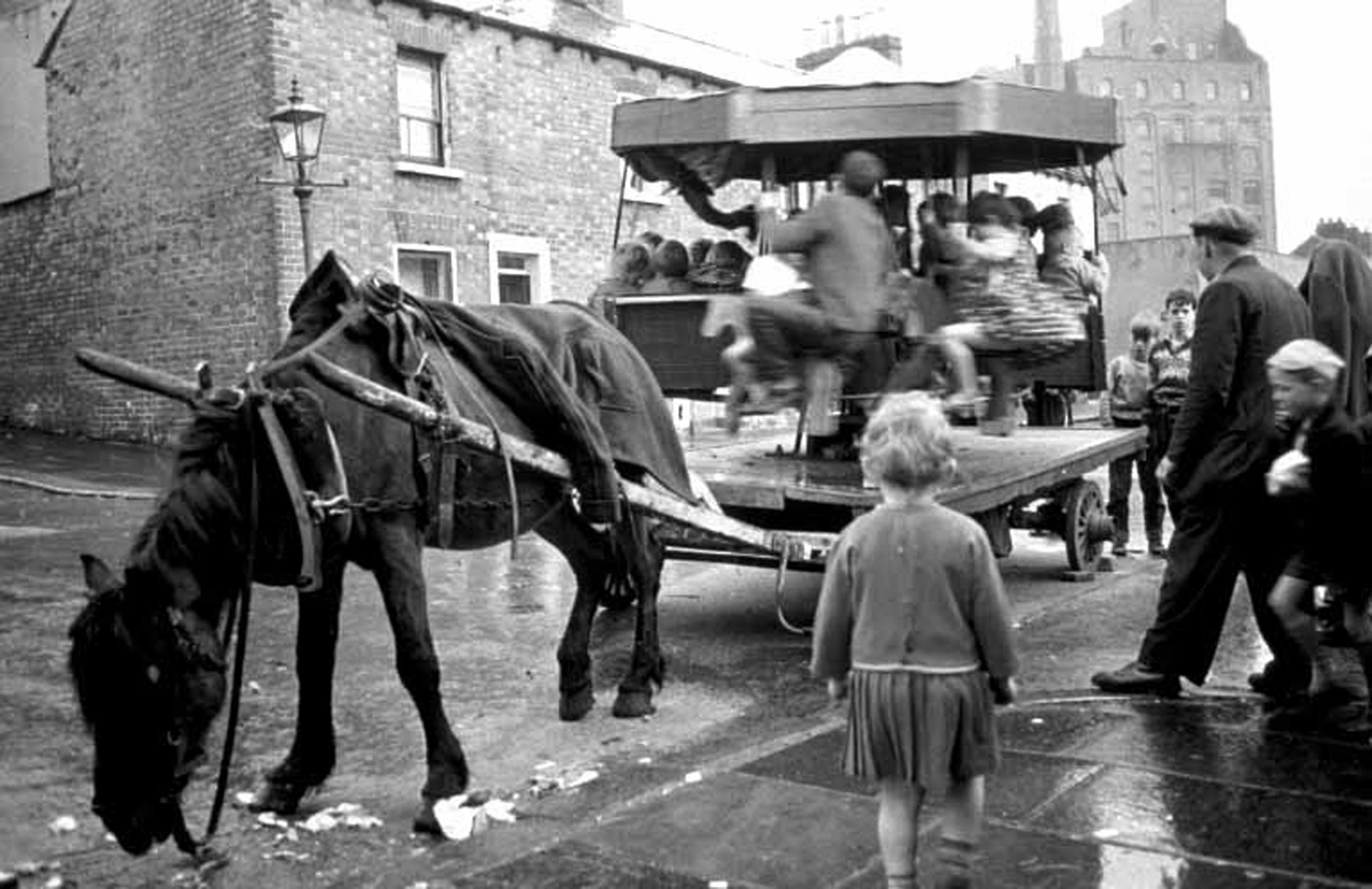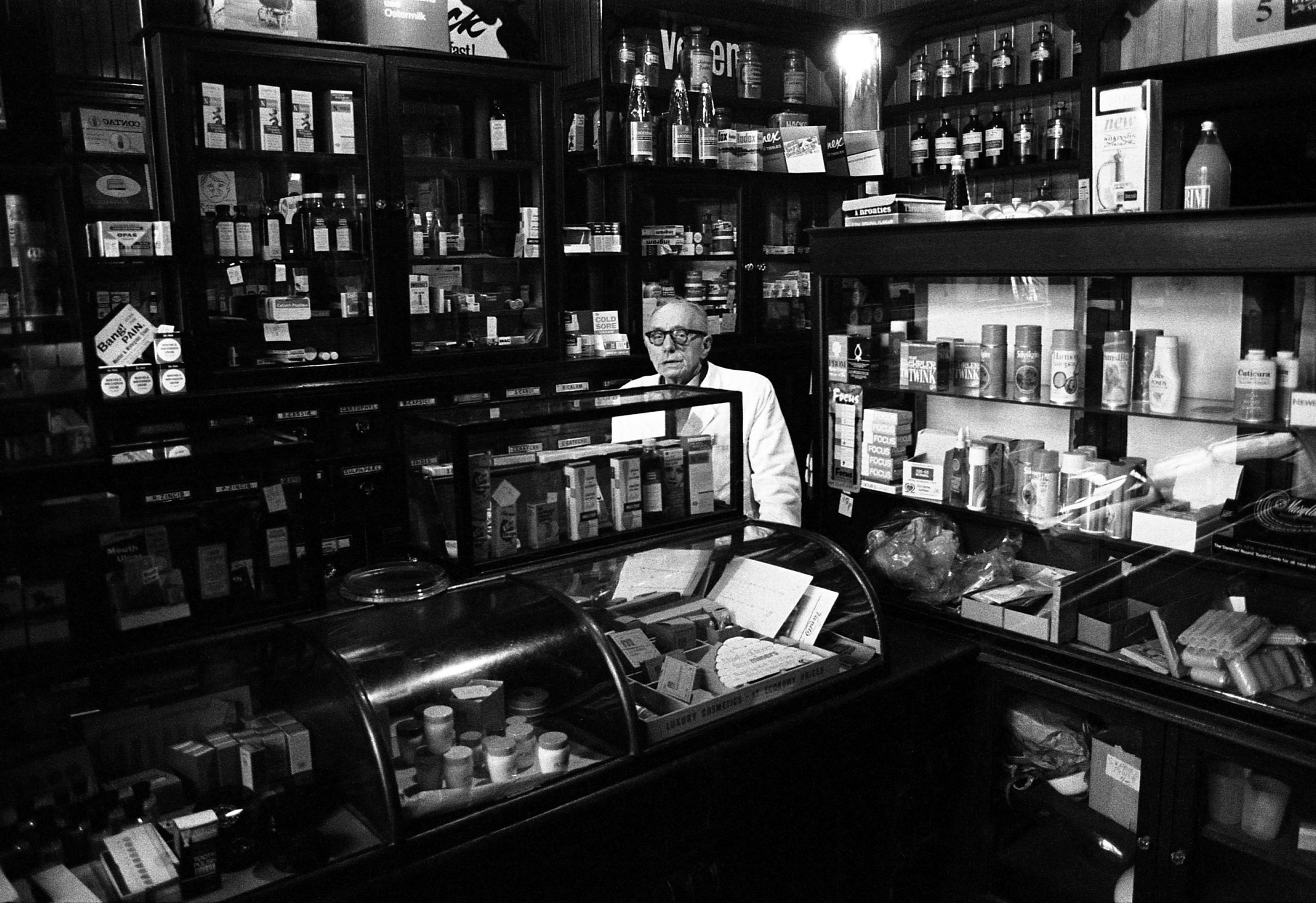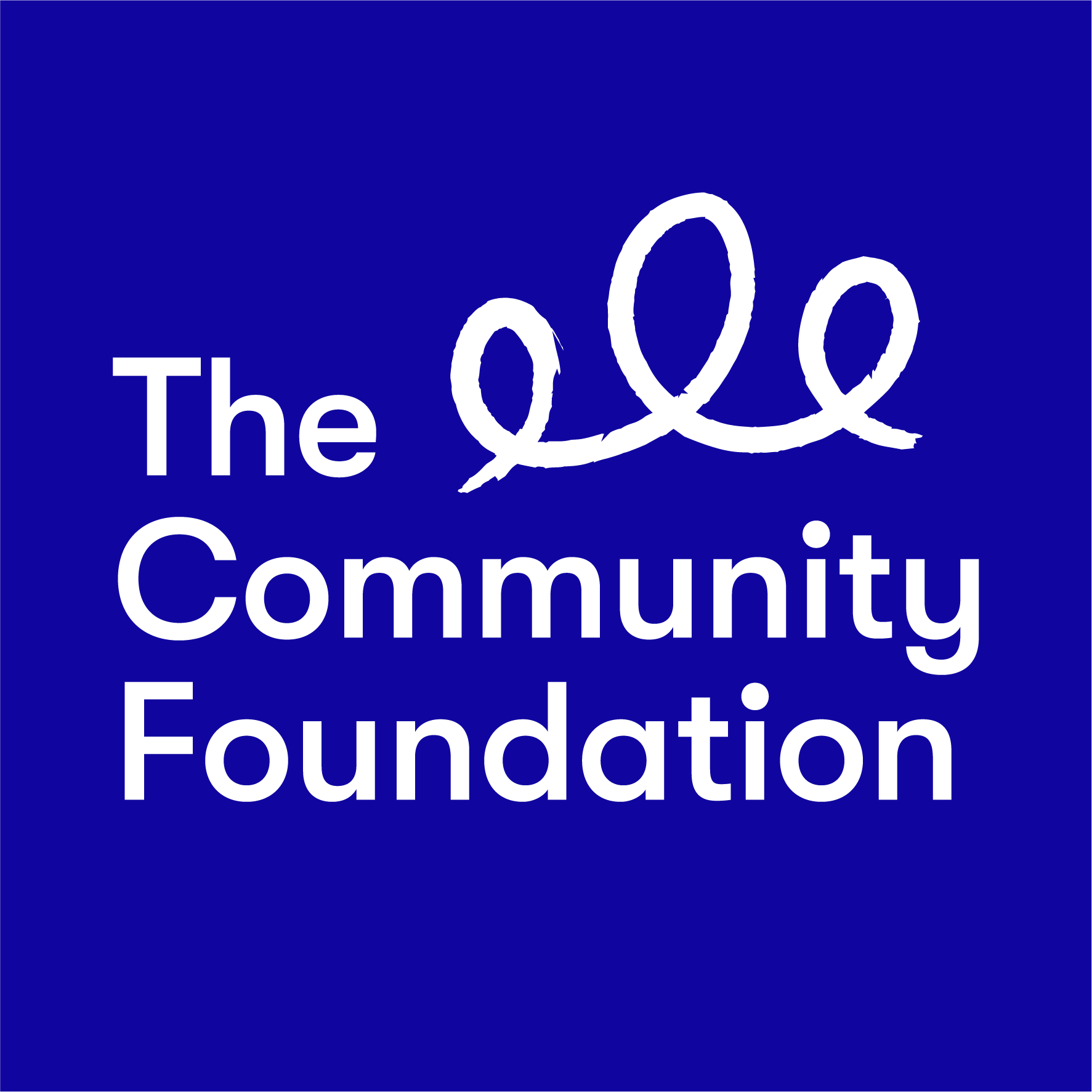Bill Kirk
Bill Kirk, the photographer
Bill Kirk was born in Newtownards. While global documentary photography was focused firmly on the “Troubles,” he was amongst the vanguard of local photographers who offered a more complex perspective on Northern Irish communities.
Kirk’s life has been shaped by two major passions: cycling and photography. Cycling became a powerful motivating force following the early deaths of Kirk’s parents to TB. It was his own life-threatening battle with the illness, alongside his redundancy as a draughtsman at Shorts, that prompted Kirk to study photography at Belfast’s Art College. He was driven, he says, “By a naive belief that photography could make a difference.”
As conflict erupted around him,“There was a lot of anxiety; everybody was anxious. We were in a fog, not knowing where we were going.” The approach he brought to his art was inspired by photographers such as Lewis Wickes Hine (whose documentary photography helped bring about a change in American child labour laws), Robert Frank and, Cartier-Bresson. This dual commitment to social and aesthetic responsibility lies behind a body of work which is steeped in a sense of common humanity, whether its subjects are eminent local figures or random instants of everyday life. Kirk’s portraits are perceptive, disclosing the complexity of the face as a bearer of histories. Kirk’s perspective was a fresh one, and a refreshing one in the context of documentary photography during conflict. Even while working for the Northern Irish Tourist Board Kirk eschewed whimsy in favour of a more sophisticated aesthetic.
General Photos
Joseph Beuys
'When Beuys came to Belfast' by Bill Kirk
When Joseph Beuys came to the New University of Ulster (Art College) in November 1974 to talk to students, Bill Kirk, himself a 2nd year student of photography snapped the proceedings.
Joseph Heinrich Beuys; (12 May 1921 – 23 January 1986) was a German artist, teacher, performance artist, and art theorist whose work reflected concepts of humanism, sociology, and anthroposophy. He was a founder of a provocative art movement known as Fluxus and was a key figure in the development of Happenings.
Beuys is known for his "extended definition of art" in which the ideas of social sculpture could potentially reshape society and politics. He frequently held open public debates on a wide range of subjects, including political, environmental, social, and long-term cultural issues.
Klondyke Bar
In my work as a photographer in the Sandy Row area of South Belfast; a base where I could shelter, think, take notes, have a couple of pork pies and a Guinness and generally ‘get my head’, became a necessity. I found myself instinctively attracted to the Klondyke Bar, perhaps because it was not an especially famous, handsome or notorious – unlike many others in Belfast.
Situated on the corner of McAdam Street, the Klondyke Bar was very typical in architecture and interior décor of the older style of Belfast public houses. The buildings housing the bar – numbers 53 and 55 Sandy Row – were originally built in 1872 and accommodated a spirit grocer’s business. Hearsay has it that a German, returning rich from the Gold Rush, came to Belfast in 1906, took out a sub-lease on the premises and converted them to a full public bar, which he called the Klondyke. The pub’s first appearance in Belfast street directories as the Klondyke Bar was in 1906, which seems to lend substance to the story. But the ‘German’, if he existed, had quite a short term of business, for by the time the valuation books of 1910 were compiled, the occupier had become Robert Wasson. He ran the bar until 1938, when he sold it to Samuel B Evans. Mr. Evans, in turn, ran the bar until April 1973, when it was bought by the Northern Ireland Housing Executive as part of the redevelopment of Sandy Row. For a period of some 63-years, therefore, the bar had only one change of owner, and perhaps part of the Klondyke’s unassuming, but very warm and welcoming character, came from this continuity.
At first sight, the Klondyke seemed to have changed little since it was built, and, compared to many pubs in Belfast whose interiors were ripped out to make way for plastic seats, dim lights and high prices, it was relatively untouched. Over the years, however, changes took place; in 1938 the little snugs (which were a feature of the days when it was regarded as indecent for women to be seen drinking alcohol in a public place) were removed, although the remnants of these wooden structures could still be seen in the pub. When the Housing Executive acquired the premises the bar’s future seemed in doubt, but happily the new owners of the business had the confidence to extend the bar at the rear.
The photographs in this book have been selected from many taken in the bar since May 1974. In my choices, I tried to avoid giving an idealised and over-romanticised picture of the place – although the fact remains that, when one enters into the life of a bar charming and delightful things just seem to keep happening of their own accord. The spirit of the Klondyke can be sensed in many little things; small animals were a common sight there – an Alsatian pup, a couple of kittens in a cardboard box on pay night (I missed the picture!), a mother with a small child on her knee, two friends playing draughts in a corner, an old man fascinated by the conversation and looks of the young. Such things could be experienced in thousands of ‘locals’ throughout Ireland and Great Britain. That they survived, and flourished, in troubled Belfast was a source of hope for the future of the city and its people.
Med format slides
Bill Kirk worked for the NI Tourist Board in the 70’s and 80’s; ‘I had the hardest job in photography at the time; finding photos of N. Ireland that would entice people to holiday here’
One day, I was asked to get a nice picture of Dunluce Castle on the North coast, the car was packed with kids and it lashed the whole way but just as we reached he castle, the clouds parted and the sun shone, some sheep came up close and helped make the photo reach the cover of the brochure! I would always get the ‘Board’ work done first and if there was time, I would have my own take on things.
Besides having to haul his kit up the Mourne Mountains for the Silent Valley scenes, he was then confronted with the next task of exposing the positive film correctly, conscious of the notoriously small leeway given by Kodachrome. (back-up 35mm were taken ‘just in case’)
Bill loves challenges like this, he tests the camera to its limits, knows the qualities of most films, is exact in the execution of exposure and composes with trademark empathy, whatever the subject.
Here is a selection from 140 of his medium format (6x6 6x4.5 6x7 and 6x9cm) images shot on Kodachrome.
Digital cameras would give a different colour and are as true as our equipment will allow.
There’s not too many people shooting medium format transparency film today!
Steel Chest, Nail in the boot and the barking dog
Bill Kirk was stills photographer for the 1986 documentary ‘Steel Chest, Nail in the Boot and the Barking Dog’ telling the story of the Belfast shipyard, Harland and Wolff, as told in story and song by those who make their living there.
Bill gained access to the famous shipyard and documented the workers and the yard with his usual empathy and skill.
Shot by filmmaker, David Hammond, back in 1986, it chronicles the stories of the men who helped to build some of the most famous ships in the world.
Mr Hammond's daughter, Catherine Gifford, worked as a production assistant on the film.
"We were supposed to start filming on 12 April, the anniversary of the Titanic leaving Ireland, which was a big coincidence," she said. "So we postponed things just in case something went wrong. "The management were wary of us at first. Work was drying up at that time and there wasn't a lot of good news to be told. "The men were a bit wary of us too, but David had a way of getting information out of people."
The film's unusual title was derived from the nicknames of some of the men, who worked at the shipyard. Catherine added: "There were a lot of Billies and Sammie's, so they all had nicknames so everyone would know which Billy or Sammy they were talking about."
Catherine said the collection is a chance for the people of Belfast to explore and appreciate the city's history.
"People see these big cranes every day and they tend to overlook the work that went on under their noses. These stories, and the kind of work that went on there, will never be heard of again. These are three very different films but they all give an insight into what life was like. This is part of our heritage.”
A Flying Fox Films Production for Channel 4 in association with Radio Telefis Eireann.
Produced and Directed by David Hammond.
Camera – David Barker; Assistant – Conor Hammond
Stills photographer - Bill Kirk
Sound – Deke Thompson; Dubbing – Tony McHugh
Music John Anderson
Commentary – Damian Gorman
Production Team – Bernie Morrison, Catherine Hammond;
Editing – Mathilde Blum; Assistant – Michael Quinn
https://digitalfilmarchive.net/media/steelchest-nail-in-the-boot-and-86#.W8eoBvGuluc.email
The men of Harland and Wolff were notorious for nicknames. Some of the characters in the Shipyard had nicknames based on their names, but others got nicknames, through things they said or did, or even through mannerisms. From Managers down to labourers, some accepted these names and proudly answered to them whilst others were used behind the persons back.
“A manager was sometimes called a ‘hat’. They wore white helmets but in bygone days they wore bowlers. A foreman was a ‘gaffer’”.
Most of the names where given with affection and In some cases people even invented their own nickname as they felt out of place without one. Not only the men got nicknames, but areas and equipment around the Yard fell foul of the general slang. The two large Gantry cranes are better known as Samson and Goliath. The Whitehouse, Big Fut, Big Boss, Joe 90, Royal Avenue, The Deep Water, the Abercorn Yard was known as "Boys Town". Even the founding partners Harland and Wolff didn't escape, often when they were there together, they were nicknamed Majestic and Teutonic respectively, after two famous liners built in 1889.
The Harbour Police got the name of the Bulkies. Those leaving the Yard with a homer would often stuff them up their coat, to which others would warn them that the item was too bulky! Hence the term "Watch out for the Bulkies".
Many of these names refer to not only one person, but many people being called by the same nickname, for example “Nail in the boot” or "Snipers Nightmare" for those that walked with a limp.
Some of the more common names are Fitzy, Minty, Scotty, Jock, Jonty, Wee Joe, Big Joe, Wee John, Big John and so on, some were even called after where they lived, Comber Bob, Portavogie, Annalong.
Arkle, Awesome, Banacheck, Bap, Battler Nelson, Beefer Moore, Big Bird, Big Hen, Big Joe, Billy Hensen, Billy Two Rods, Bin Bag, Black Bob, Blackie, Blondie , Blondie ,raig, Bo Daddy, Bootsy, Budgie Kerr, Buff Duncan, Bullybeef, Bunter, Busted Drum, Buster, Buzz, Capt Ahab, Capt. Ahab, Cat Weasel, Chalky, Cheeky Charlie, China, ,Chopalot, Chunky, Cochise, Comber Bob, Corky, Crazy Horse, Danny Doors, Dollar a Half, Duck Morrow, F.L.U.B., F.U.B., Father Jack, Fish, Fitzy, Galpin, Geordie ,Beep Beep, Geordie Walkabout, Grasshopper, Hamburger, Happy Feet, Hard Core, Hard Head, Harry O, Harry Sackem, Harry the Horse, Heart Attack, Heavy Bangle, ,Horizontal, Hoss, Inch High, Itchy Coo, Jamsy, Jelly Man, Jim Jim, Jock, Johnny Scissorhands, Joker, Jonty, Larry the Lamb, Lazer Beam, Lazy-Hands , Locksly, Mad Millar, Marlie Head, Me Mammy, Minty, Mr Blobby, Mucker, Nail in the Boot, Nerves of Steel, Nipper, Nuck-Nuck, Onion Eyes, Parking Meter, Pick em and flick em, Pinky & Perky, Plum, Plum and Malky Mo, Pockets, Poker, Pop-up, Puskas, Rab-A-Dab, Rab-Rotten-Root, "Rawhide"( because he used to shout at his men "get em up and move them out"), Rocky, Rod-the-Prod, Rubber Gub, Ruby, Sammy No More, Scoobie Breasly, Scoop, Scotty, Scud Martin, Seagull , Seaspray, Seldom, Shipyard Joe, Short-Arse, Silver Back, Silver Bark, Skin, Slasher Steel, Slugger, Snake, Snipers Nightmare, Sonic, Spam , Spitting Pig, Split-Pin, Steadyman, Stuffer Kane, Suck the Butt, Tank, Tanto, Tarzan, Tea Bags, Tear the Beef, Teflon, The Plank, The Badger, The Black Prince, The Brown Bomber, The Cardinal, The Clock, The Cloud, The Clutching Hand, The Dark Destroyer, The Dickler, The Gabo, The Gabo/Gabalooney, The Galloping Major, The General, The Hawk, The Heart, The Honeymonster, The Hulk, The International Welder, The Likely Lads, The Mexican, The Olympic Flame, The Penquin, The Pup, The Rat, The Rat Catcher, The Sandancer, The Scarf, The Screaming Skull, The Seagull, The Shadow Boxer, The Skinny Man, The Skip, The Skull, The Way We, The Wee Soldier, The Wireless, The Womble, The Wooden Welder, Tinopener, Tiny Tears, Tommy Snags, Tugboat Wilson, Uncle, Uncle and Scoop, Waldo, ,Warewolf, Wee Huck, Wee Jack Russell, Wee Joe, Wee Legs, Wee Wheels, Whalebone, Whistler, Why Me, Wishbone, Wooden Top, Wurzell Gummage, Yellow Pack, Zebo Man. ............. but some of the nicknames are classics:
The Wooden Welder - this name was given to a welder who tried to weld wood to steel on a ship. Both were painted grey and looked very alike he spent a number of hours and a large number of rods before he discovered his mistake. By the way he was a well known Irish League and International Footballer who still takes a ribbing over that incident.
Washing Soda - he was the guy who ran the first aid room and treated everybody and injury with washing soda.
Hard Wrought - so called because he did nothing but made it look like he was worked of his feet.
Wire Sail - was given this name because he was a tall thin man who wore a flat cap.
Tired Hands - given to a man who every time he was asked to do something said 1 cant my hands are tired.
The Barking Dog - He was one of the best known of all the characters in the yard the story is that if he liked you he talked to you if he did not like you and that was most men he barked like a dog at you.
Lemonade Walker - Lemonade was employed by H&W for over 30 years and spent the most of it running a shop giving tic to men so as they could get fags. He also sold crisps and other tuck shop goods and got the name because he was a whiskey and lemonade man, very rare in those days to have someone drink lemonade with a Black Bush.
Bits and Pieces - a fitter who wrecked more than he fixed.
The Mandarin - He was a man with a toe missing and when was walking his feet turned out he had a moustache and was very yellow in appearance hence the name.
Dread the Winter - he had a hole in his boot and always said he dreaded the winter coming.
Bungalow - He was a man who had plenty downstairs but nothing upstairs.
Forty Watts - he was not too bright.
One Run Dick - he was a foreman and he would only pay you for one run on plate if the plate was wide you needed two runs but he would still insist on paying bonus on one run to save the company money.
Desperation Dick - another foreman who would come up to you and say, leave that job and come with me “I am in desperation”.
Fowl Pest - he insisted on feeding the seagulls and gannets. He also fed the rats and the wild cats.
Buckets McGaughey - Now buckets was an old boxer and street tighter who fought in the Chapel Fields and the booths at York Street. He got his name because no one could knock him out and the only way sometimes to stop him was to hit him over the head with the ringside bucket.
Blaze Away - OBE. This man worked as a burner and would have knocked you out of the way so he could work. He was on the staging before the starting horn went and also at lunch time so he could get started right away. He worked in the yard for 35 years and never had a day off ill in that time and he was rewarded for his service with an OBE from the Queen for his services to the ship building Industry. Sadly he was laid off in the 1990s and as a result he could not live without his work and also the Shipyard that night he took his own life. Many of the men who spent their lives in the yard really could not adjust to life without it.
Alan Thomson - was called Seaweed because he and a couple of apprentices used to go for a swim in the building dock before it was finished. He came out of the water one day covered in seaweed, hence the nickname. He had "Seaweed" tattooed on his arm.
A Man they called "Stanley Matthews" every time something was to be lifted, he would say "Ill Take This Corner".
Triple D (Deeply Depressing Davey)
Onion Eyes - A manager (Frank Piggott) that made a man cry when he paid him off
Bob Cosgrove (Paddy) - He started in H&W in 1912 to serve his time as a riveter; he was told that there was no future in riveting and he would be lucky to finish his time as an apprentice. Fifty one years later he retired still employed as a riveter. He was regarded by many of his workmates as one of the best the yard had produced, quite a compliment. At his Funeral a couple of older men were standing Crying, one “Wee Gordie” was his heater boy and the other "Davy" was his holder-up, they had worked together for 36 years as a riveting squad. He was a member of what was called the “Millionaires Club” this was the name given to the riveters because they earned good money on peace work (Bonus).
Photo Finish. The man who walked with a forward stoop.
The Sniper’s Nightmare. Jack Johnson after falling down a hatch and getting a side-to-side limp.
A stager called “Seaspray” (pointed the wrong way when doing a pee in the wind).
The White Rhino. The joiner who lived in Kenya for a few years.
The Barking Pup. The barking dog’s son.
Franz Von Piggott – written on the dirt on the joiners van surrounded by swastikas.
Sailor McCracken – ex submariner.
The Chief – Billy Steele who always said “I’m the fucking chief”.
Indian Joe - A swarthy joiner.
Everton Mints - Hughie McCrea who always rattled his new false teeth when talking.
The White Knight - Spark in Kings Works who always had spotless white overalls on.
Sooty Campbell - Always had dirt on his face.
The Desert Rat - Electrical foreman who had fought at El Alamein during WW2.
The Muppet - Had an appearance like the drummer in the Muppet Show. (John Hill, electrical foreman).
The Budgie - Wore a yellow jumper.
The Cardboard Cut-out - because he leaned over the hand rail till he seen a foreman.
The Passing Cloud - Crane driver who was always smoking
Me Mammy - Always talking about his mother.
The Ghost - A manager who always appeared from nowhere.
The Scarf - A foreman who was always hanging around you.
Yabie Dabie - An electrician who was always singing the Flintstone song.
Drill Bit - Someone who was boring.
Frank Sinatra, every job wee went to he would say to me “You'll do it my way”
The Clock - He had one arm longer that the other.
FUB - Fat Useless Bastard
FLUB - Fat Lazy Useless Bastard
Shops
Bill kirk has always had a fascination with small shops, independent traders who were the backbone of any community……
Sandy Row, 1974
When an anxious wife forbade her professional photographer husband from coming to Belfast, it led to a productive coincidence for local photographer Bill Kirk. The photographer worked for the English developers Building Design Partnership, who wanted to record the area as part of the restructuring process. Kirk was already involved in a personal project to document the area in 1974, having heard (while in college) that it was to be entirely redeveloped. The two projects found a natural fit, and the result is a series of irreplaceable images of a community in the throes of conflict and on the brink of major transformation.
Sandy Row, Now
With the support of the Heritage Lottery Fund and the Belfast City Council, we’ve been documenting the Sandy Row community with the legendary local photographer, Bill Kirk.
This idea started in early 2016 following the success of Kirk’s BAP exhibition and book of photographs from 1974. The idea was one of a number of projects identified after his entire collection of negatives were scanned and preserved by BAP over the previous year.
“Sandy Row Revisited” came about after the realisation that what was missing from the images were the stories behind them. We were spurred on by the untimely death of Jackie Robinson, a fountain of knowledge about the area and set about the task of gathering oral histories.
The Home Place
100% of every donation goes directly to programming. We deeply appreciate your support!
Social media
-
Great book launch for Michael McCann at Cultúrlann! Pick up a copy of his Burnt Out: How the Troubles Began!… https://t.co/M9GHarkXCG
-
RT @Inter_Arch: Nice to see more material on the Belfast Archive website. Includes Gerry Collins shots of Bombay St in August 1969… https://t.co/kgtGGySLiK
-
RT @Inter_Arch: Bombay St, 1969 and first (Troubles-era) barricades in #Belfast. Photos by Gerry Kelly on @ArchiveBelfast https://t.co/H4mAW2GHRX
-
Thanks Vicky! https://t.co/MhiaSys4Lr
-
Planning some great projects for the year! https://t.co/c3zz0DXaqi
-
We have come a long way since we started building the BAP two years ago. Check out this 2016 article from the Irish… https://t.co/SJF7nHksDD
-
The BAP is located in the historic Conway Mill. We are currently finishing up our photographic and oral history wor… https://t.co/fbVAA4w4aU
-
Exciting about our new website! Official launch December 17, but take a sneak peek: https://t.co/6S2EGnl46b





































































Commodo cursus magna, vel scelerisque nisl consectetur et. Donec id elit non mi porta gravida at eget metus.